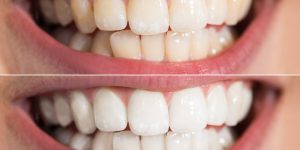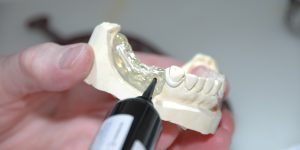Crowns – overview
What is a crown made of? Crowns can be made of a variety of different materials and new materials are continually being introduced. Some of the most popular options are listed below. Porcelain bonded to precious metal: this is what most crowns are made from. A precious metal base is made and then porcelain is applied in layers over it.
Temporary crown: A temporary crown (provisional crown, interim crown) is a temporary (short-term) crown used in dentistry. Like other interim restorations, it serves until a final (definitive) restoration can be inserted. Usually, the temporary crown is constructed from a chemical-cure composite, although alternative systems using aluminium crown forms are occasionally used. Temporary crowns function to protect the tooth, prevent teeth shifting, provide cosmetics, shape the gum tissue properly, and prevent sensitivity.
Porcelain: these crowns are made entirely out of porcelain and are not as strong as bonded crowns. But they can look very natural and are most often used for front teeth.
All-ceramic: this modern technique offers a metal-free alternative, which can give the strength of a bonded crown and the appearance of a porcelain crown. Therefore it is suitable for use in all areas of the mouth.
Glass: these crowns look very natural and can be used anywhere in the mouth.
Gold-alloy crowns: gold is one of the oldest filling materials. Today it is used with other metal alloys to increase its strength, which makes it very hardwearing. These crowns are silver or gold in colour.
Porcelain bonded crows
A crown is an artificial restoration that fits over the remaining part of a prepared tooth, adding strength and creating a natural appearance. Dental crowns are commonly known as ‘Caps’. They are effectively a tooth-shaped hat that sits over the tooth.
Generally, the tooth is prepared for a crown by reducing it on its circumference by approximately 1mm allowing space for the crown to sit on top of the remaining core. Porcelain bonded to metal crowns are an ideal restoration for teeth that have broken down or have been weakened by decay or a very large filling.
A crown could be used for a number of other reasons, for instance: You may have discoloured fillings and would like to improve the appearance of the tooth. Following root canal treatment a crown may be needed to strengthen the tooth. To improve the cosmetic appearance and aesthetics of your smile. If you have a dental implant to replace a missing tooth a crown will be fitted on top of the titanium implant. To close gaps between teeth giving a more uniform smile. If a tooth is slightly out of position a crown may be used to align it with your other teeth.
A crown can be made to mask any internal staining of your teeth. To close gaps to avoid food trapping. Porcelain bonded crowns are made from a metal layer underneath with porcelain layered over the metal. They are suitable for anterior and posterior teeth, however, after time crowns that are made from a combination of metal fused to porcelain, can begin to show a dark shadow on the margin closest to the gum. This is due to the gum receding over time and exposing the neck of the crown where the porcelain over the metal work is at its thinnest. This is generally not a consideration on posterior teeth but anteriorly in the mouth patients may want to consider a crown that does not have a metal substructure.
Metal-free porcelain crown
The all-ceramic e.max crown has many advantages over traditional crowns. Besides its high esthetic qualities, the function and longevity of the crown is excellent as well.
E.max is a system of crown fabrication which allows a porcelain crown to be made without the metal understructure. Traditionally, porcelain crowns are made by bonding the porcelain to metal support The drawback is that unlike a natural tooth which exhibits a certain degree of translucency, the metal framework under the porcelain blocks out the light. To the keen observer, the difference in shine and translucency between a natural tooth and can be quite obvious. While full porcelain crowns have been done (and are still being done), most have proven to break prematurely. Furthermore, porcelain surfaces are known to wear out opposing natural teeth faster.
The E.max system, unlike its metal-based predecessors, has developed a method of making a ceramic crown without metal that is both durable and aesthetic. Since the crown is made entirely out of ceramic, it can have the same translucency as natural teeth.
Simply put, a new all-ceramic e.max crown is esthetically superior to any other type of crown. You just can’t get the same finish and natural, living look with a traditional metalcore (porcelain fused to metal) crown.
Dentures
Dentures are removable false teeth made of acrylic (plastic), nylon or metal.
They fit snugly over the gums to replace missing teeth and eliminate potential problems
caused by gaps. Gaps left by missing teeth can cause problems with eating and speech, and teeth either side of the gap may grow into space at an angle. Sometimes all the teeth need to be removed and replaced.
You may, therefore, need either:
- complete dentures (a full set) – which replace all your upper or lower teeth, or
- partial dentures – which replace just 1 tooth or a few missing teeth
Dentures may help prevent problems with eating and speech and if you need complete
dentures, they may also improve the appearance of your smile and give you confidence.
Complete dentures
A full denture will be fitted if all your upper or lower teeth need to be removed or
you’re having an old complete denture replaced. If you have dentures fitted immediately after the removal of several teeth, the gums and bone will alter in shape fairly quickly and the dentures will probably need relining or remaking after a few months.
Occasionally, your gums may need to be left to heal and alter in shape for several
months before dentures can be fitted.
Partial dentures
A partial denture is designed to fill in the gaps left by one or more missing teeth. It’s a plastic, nylon or metal plate with a number of false teeth attached to it.
It usually clips onto some of your natural teeth via metal clasps, which hold it
securely in place in your mouth. It can easily be unclipped and removed.
Mouthguards and mouth splints
If you grind your teeth while you’re asleep, it may help to wear a mouth guard or
mouth splint at night. Mouthguards and splints even out the pressure across your jaw and create a physical barrier between your upper and lower teeth to protect them from further
damage. They can also reduce any grinding noises you make at night.
Mouthguards are similar to those used in sports such as boxing or rugby. They’re
rubber or plastic and can be made by your dentist to fit your mouth. You can also
buy a mouthguard from your local pharmacist, but it’s unlikely to fit as well as a
custom-made one.
A mouth splint is made from harder plastic and fits precisely over your upper or lower
teeth. They’re no more effective than mouth guards in reducing the symptoms of
teeth grinding. However, they’re more expensive as they last for several years,
whereas mouth guards usually only last for less than a year.












